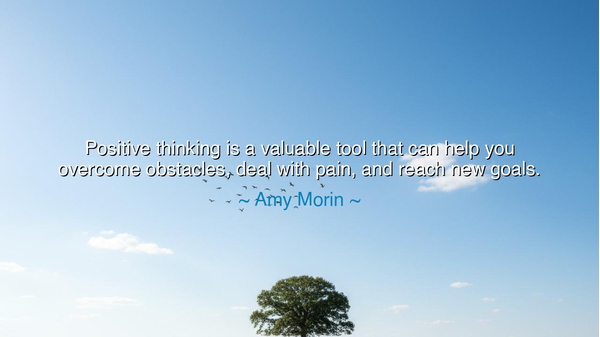
Positive thinking is a valuable tool that can help you overcome
Positive thinking is a valuable tool that can help you overcome obstacles, deal with pain, and reach new goals.






When Amy Morin declared, “Positive thinking is a valuable tool that can help you overcome obstacles, deal with pain, and reach new goals,” she was not offering mere comfort, but unveiling a truth as old as humanity’s struggles. Her words remind us that the battles of life are not won by strength of the body alone, but by the strength of the mind and the resilience of the heart. For in times of darkness, it is positive thinking that becomes a lantern, guiding us through trial and leading us toward victory.
The ancients themselves understood this secret. Marcus Aurelius, emperor and Stoic, wrote in his meditations that the soul becomes dyed with the color of its thoughts. If the mind is filled with despair, despair will shape the man. If the mind is filled with courage and hope, then no obstacle can fully conquer him. Thus, Morin’s wisdom is a continuation of this eternal teaching: that the thoughts we hold are weapons or shackles, depending on how we wield them. Positive thinking is the weapon that cuts through hardship.
History, too, bears witness. Consider the life of Helen Keller, who was struck blind and deaf at the age of two. By the measure of the world, her obstacles were insurmountable. Yet through unyielding perseverance and the power of a hopeful mind, she became a writer, activist, and inspiration to millions. She did not deny her pain, but she transformed it, guided always by positive thinking that pushed her beyond what others thought possible. Her life reveals the truth of Morin’s words: with the right mindset, even walls of stone can become gateways.
But this teaching is not only for the great names of history. Every person walks through valleys of trial — whether illness, loss, or disappointment. The temptation in such times is to surrender to bitterness, to let pain consume the soul. Yet it is here that positive thinking becomes not a luxury but a necessity. To believe that healing is possible, that endurance has meaning, and that new goals can still be reached — this is the shield that protects the heart from despair.
At its core, Morin’s wisdom is about transformation. Obstacles are not always removed; pain is not always erased. But through positive thinking, they are reshaped into stepping stones. The mountain does not vanish, but the climber gains the strength to ascend. The wound does not disappear, but the sufferer finds purpose in endurance. The goal may seem distant, yet hope gives wings to the weary, carrying them forward step by step.
The lesson is clear: guard your thoughts, for they shape your destiny. When you encounter an obstacle, refuse to see only the barrier; look also for the path through it. When pain enters your life, acknowledge it, but do not let it devour you; seek the lesson and the strength it brings. And when you set new goals, feed your mind with the belief that they can be achieved, for belief itself is the foundation of action.
In practice, this means cultivating habits of positive thinking daily. Begin and end each day with gratitude. Speak words of hope even when fear tempts silence. Surround yourself with voices and companions who encourage, rather than those who drag you into despair. Write down goals, envision their fulfillment, and take small steps with determination. In doing so, you train your mind to become your greatest ally rather than your fiercest enemy.
Therefore, remember Amy Morin’s wisdom: positive thinking is a valuable tool. It is the key that unlocks resilience, the light that dispels darkness, the strength that transforms pain into growth. Hold it close, sharpen it daily, and wield it with courage. For with it, you will overcome, endure, and rise beyond the limits you once thought bound you.






VDnguyen van dat
I feel inspired by the idea that mindset can actively shape our experiences, but I also wonder about limitations. Are there circumstances where obstacles or pain are too overwhelming for positive thinking alone? How can people integrate this tool with practical planning, support systems, and problem-solving? I’d like to explore strategies for applying optimism in a way that’s empowering, actionable, and grounded in reality.
PNNguyen Ngoc Phuong Nhi
Reading this makes me reflect on the role of mindset in achieving goals. Could cultivating a habit of positive thinking help people navigate failures more effectively and maintain motivation? I’d like perspectives on whether positivity is more effective in certain situations, like career growth or personal relationships, and how cultural or personality differences might influence the impact of a positive outlook.
GDGold D.dragon
This statement makes me think about the psychological benefits of optimism, yet I question whether focusing on positive thinking could sometimes minimize real struggles or valid emotions. Is there a risk of encouraging toxic positivity, where people feel pressured to stay upbeat despite pain? I’d like to explore how balancing positive thinking with realistic acknowledgment of challenges can create both resilience and emotional authenticity.
NVNguyen Van
I find this perspective encouraging because it frames positive thinking as an actionable tool rather than just wishful thinking. But I also wonder, can positivity alone truly overcome obstacles, or does it need to be paired with concrete strategies and effort? I’m curious about how people maintain optimism during prolonged challenges without feeling frustrated or deluded, and whether mindset alone can meaningfully influence outcomes.